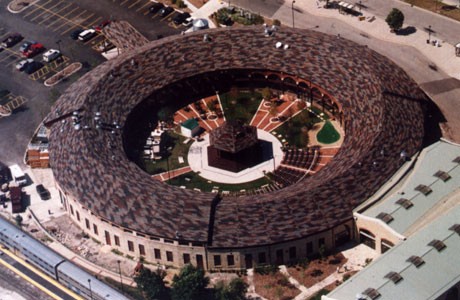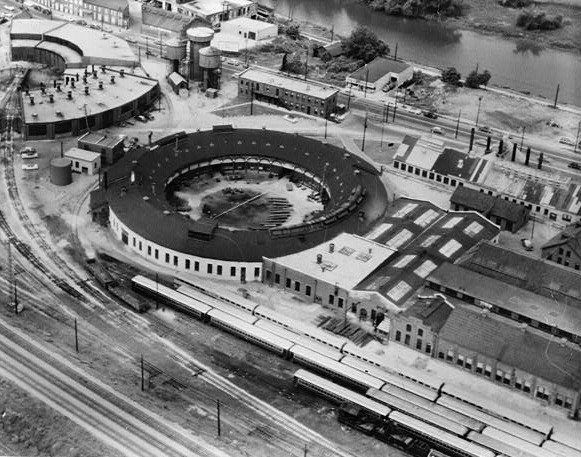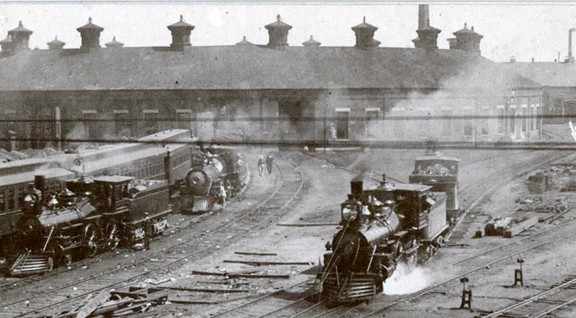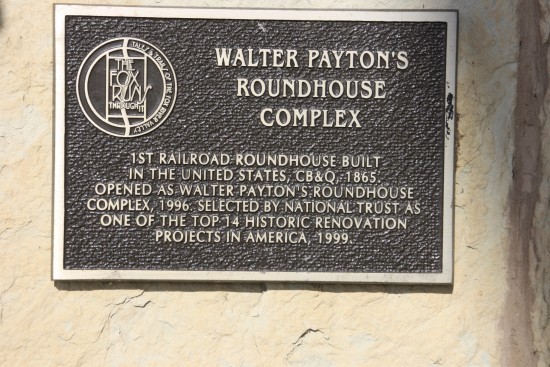The Aurora Roundhouse
Introduction
Text-to-speech Audio
The Roundhouse opened in 1856 (Aurora, Illinois) as the site for a major car building and repair shop by the Chicago Burlington and Quincy Railroad. Originally, twenty-two stalls were built, but by 1864 another 18 were added, making it a complete circle. In 1925, the entire building was replaced with a more modern roundhouse, and it remained in service until the 1970s. In In 1995 the Roundhouse was bought by an investment group, led by former Chicago Bears running back Walter Payton, who transformed the roundhouse into a Brewing Company and entertainment venue, as well as Walter Payton museum. In 2011, they sold the building to craft brewer, Two Brothers Brewing, who currently occupy the space. The building is the oldest limestone roundhouse in the United States and it is listed on the National Register of Historic Places.
Images
Source: Several outlets, including Flickr.com and WikiCommons.

Roundhouse in the 1930s

Locomotives using the roundhouse

Two Brothers Brewing now uses the inside area as a beer garden and entertainment center.

Photo Credit: Annemarie Verweij

Backstory and Context
Text-to-speech Audio
The railroad roundhouse connects the prevalence of modern society's burgeoning service-industry to that of the 19th century, dominated by industry, railways, and westward expansion.
The Chicago, Burlington and Quincy Railroad, who built the roundhouse, was the first railroad to form the link between Chicago and the Mississippi River. The first phase of construction started in 1855 and ended in 1857, consisting of seven buildings that housed 22 stalls, an engine room and shops comprised of Blacksmiths, carpenters, car and train painters, and machinists. Several hundred locomotives were produced at the Roundhouse from its genesis to roughly World War I, and the 350 employees that started when it opened grew to more than 2,000 during its peak.1
Construction continued through the Civil War era, with 18 more stalls added; the roundhouse became a completed circle in 1864. At the roundhouse, Charles Jauriet invented a special compatible firebox that allowed trains to use coal instead of wood. As well, The Pullman hotel car was built at the Rounhouse in 1866 as was the first American diner car, in 1868.2
The roundhouse had a profound effect on Aurora, IL (circa 1837). Sitting at the Fox River, it was a bustling trade center evidenced by constant horse wagon traffic, largely benefitting from its preferred location as the main westward route from Chicago to the Fox River. By 1849, the Galena and Chicago Union Railroad extended a railroad track from Chicago to Turner Junction, located 12 miles to the north of Aurora, which decreased the round triptravel time to Chicago from three days by horse to a single day. That put Aurora in danger of losing its place as a small, regional hub; railroads held significant weight to a city's success in the mid 1850s. Hence, On February 12, 1849 Lorenzo D. Brady, a member of the Illinois legislature from Kane County, where Aurora is located, obtained a state charger to establish the Aurora Branch Railroad. Without that effort, the roundhouse likely would not have been built. Thus, the building also exists as a sign of a town's need to secure a railroad for its survival, as it were. The roundhouse and the town's ability to connect to Chicago (and elsewhere) via the train fostered substantial growth for the town, and it become one of Chicago's biggest suburbs, which can be attributed to the railroad.3
In the 1970s, when railway use declined, and became much less significant as an economic force, the roundhouse ceased operating and fell into disrepair. However, in 1995, the famous Hall of Fame National Football League running back, Walter Payton, and his investment partners, purchased the building and turned it into an entertainment venue. Akin to Omaha's meatpacking district that transformed from a meatpacking center to that of retail, service, and artist shops, the new use of the building signified a change from a heavy reliance by towns on industry to that of the service industry, such as retail, food and beverage, hotels, and related industries.4
In 2011, Two Brothers Brewing Company took control of the place, a result of the craft-beer boom occurring in the U.S., largely attached to the end of prohibition laws that prevented homebrewing until 1978. At that time, less than 100 breweries operated in the U.S, but as of 2016, more than 4,6000 breweries exist.5
The limestone roundhouse provides an immense amount of history, from its original purpose to that of its modern day use. To walk into the doors of the roundhouse is to experience the legacy of the American and Chicago railroad history, the fame of a sports star, the transition from large industry economy to a service economy and the craft-beer boom, which enjoys a history all to itself.
Sources
1 "Chicago, Burlington & Quincy Railroad Roundhouse," The American Society of
Mechanical Engineers (1988), accessed Oct 18, 2016, https://www.asme.org/getmedia/dbbaf750-bd7a-4579-a18c-8d920930ab07/132-Chicago-Burlington-Quincy-Railroad-Roundhou.aspx.
2 John H White, Jr. The American Railroad Passenger Car, (Baltimore: Johns Hopkins University Press, 1978) 500-505, 644-648.
3 Ann Keating, Chicagoland: City and Suburbs in the Railroad Age (Chicago: University of Chicago Press, 2005), 5-6, 185.
4 Doug Short, "Charting The Incredible Shift From Manufacturing To Services In America," Business Insider, businessinsider.com, September 5, 2011, http://www.businessinsider.com/charting-the-incredible-shift-from-manufacturing-to-services-in-america-2011-9
5 Brewers Association Statistics, BrewersAssocation.org, accessed October 13, 2016, https://www.brewersassociation.org/statistics/number-of-breweries/
Additional Reading:
Ascher, Scott. 140 Years of the Aurora Roundhouse History : A Chronology of America's First Roundhouse.
